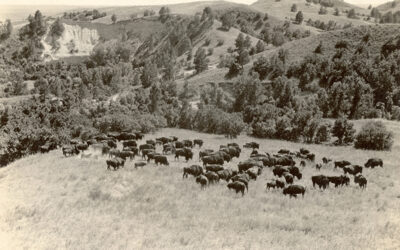Centennial observances by Fort Calhoun residents of the Lewis and Clark expedition’s visit to their locality took place during the summer of 1904. The Blair Pilot of August 10 and 15, 1904, reported that a huge boulder, six tons in weight, was in place and would soon be dedicated as a monument, “thanks to our committee. Dr. Curtis and Henry Rix and the pushing energy of Pioneer James Vaughan and his helpers also [speaker’s] stand and seats. The sandwich counter of Arthur Bauman is ready for the hungry. The city council voted $25 to the monument committee.”
Prominent guests included Senator Joseph H. Millard of Omaha; Edward Rosewater of the Omaha Bee; Mrs. Abraham Allee, state regent of the Daughters of the American Revolution, who presided at the exercises; William F. Gurley, orator of the day; ex-Governor James E. Boyd; and J. W. Battin of Omaha, president of the Sons of the American Revolution. Also present were S. C. Hessey and Mrs. E. E. Hessey, “members of Capt. Clark’s family . . . [who] came for information of their illustrious ancestor and living relatives.” Letters were read from President Theodore Roosevelt and ex-Governor Lorenzo Crounse.
Gurley, as orator of the day, said, “The Nebraska State Historical Society and the local chapters of the Sons and Daughters of the American Revolution have made possible these memorial exercises; unique in their character, yet altogether worthy of the time and labor bestowed.” J. A. Barrett of the Nebraska State Historical Society gave an address entitled “The Meaning of the Council of 1804.” Governor John Mickey and Edward Rosewater also spoke briefly.
“The unveiling of the boulder monument came last. Mrs. S. B. Pound of Lincoln, chairman of the D.A.R. committee, delivered the address at the ceremony in a simple, yet instructive manner. Mrs. Pound said that the boulder which comprised the monument was found on a Nebraska farm near Lincoln, evidently having come there ages before in glacial formation.”
The Pilot concluded by congratulating the band that had provided music for the day and noted several centennial-related souvenirs: buttons (none remaining) and printed programs (still available by mail).



